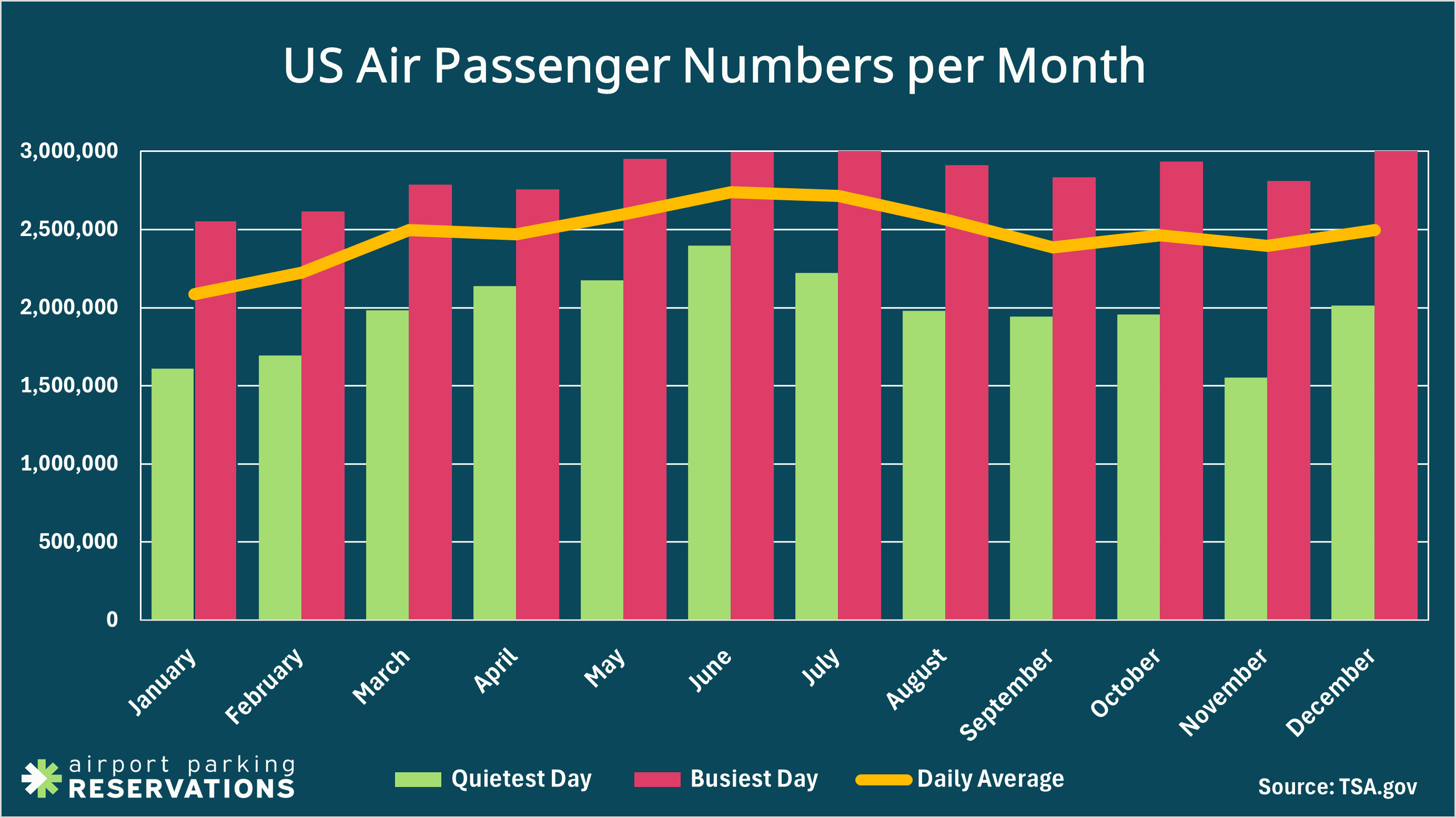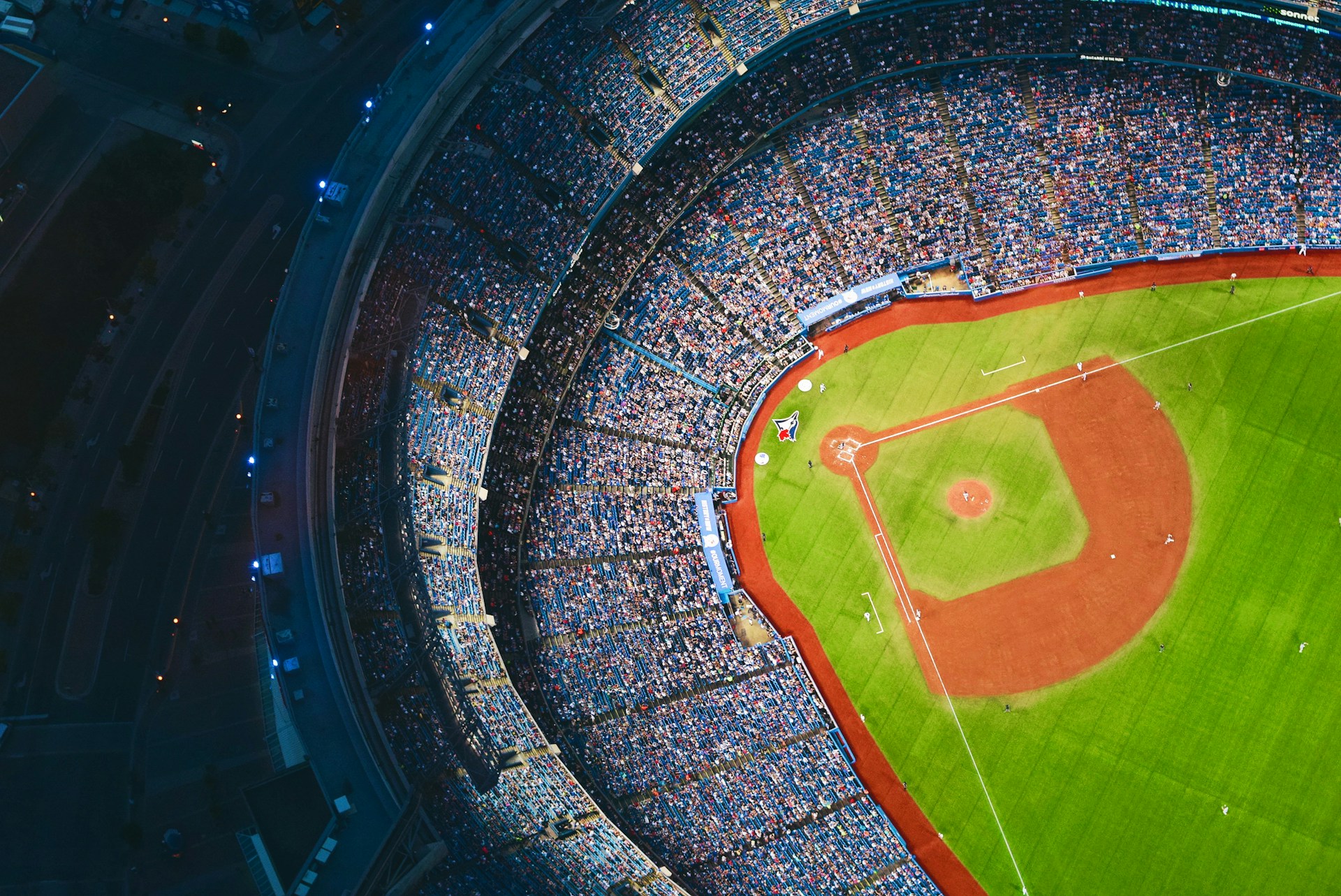The busiest days of the year for air and road travel are those around Thanksgiving and the year-end festive holidays. However, other days can be just as congested.
Passenger numbers surge year-round as events and tourism drive demand. So, which days should travelers avoid?
In this guide, there is a full breakdown of the busiest days, months, and periods to travel.
Busiest Travel Periods of the Year
Check out our list of busiest travel days in the US and read up on what you can do to avoid travel issues.
- Busiest Days to Travel
- Busiest Months to Travel
- Thanksgiving Travel
- Travel over the Winter Holidays
- Spring Break Travel
- Event Travel
- Strategies for Simpler Travel
Busiest Days to Travel
According to passenger numbers published by the TSA, these are the top 15 busiest travel days of the year:
- December 1, 2024: 3,088,836 passengers.
- July 7, 2024: 3,013,622 passengers.
- June 23, 2024: 2,996,495 passengers.
- July 18, 2024: 2,957,170 passengers.
- May 24, 2024: 2,951,859 passengers.
- June 24, 2024: 2,944,001 passengers.
- June 28, 2024: 2,938,292 passengers.
- July 14, 2024: 2,937,845 passengers.
- October 20, 2024: 2,934,025 passengers.
- June 14, 2024: 2,929,467 passengers.
- July 25, 2024: 2,924,478 passengers.
- July 28, 2024: 2,922,306 passengers.
- June 27, 2024: 2,921,687 passengers.
- June 9, 2024: 2,915,830 passengers.
- August 30, 2024: 2,913,547 passengers.
If you’re thinking of traveling on any of these dates, ensure you’re well prepared just in case you get stuck in heavy traffic or suffer a breakdown, and give yourself adequate time so that you can take any issues that confront you in your stride.
Busy travel days are likely to make your trip longer. There are more traffic jams on the roads, more seats are filled on airplanes, and extended lines at TSA. You may lose your seat if the flight is overbooked, and delays can cause you to miss connections.
One way to reduce stress is to plan ahead and reserve your airport parking. One less thing to worry about!
Busiest Months to Travel
To determine the busiest periods, we reviewed the TSA’s data by the daily numbers and calculated the monthly totals and averages. So, when is the busiest time of the year?
Total Passenger Trends (2024 Overview)

| Total | Daily Average | Quietest Day | Busiest Day | |
|---|---|---|---|---|
| January | 64,647,251 | 2,085,395 | 1,610,765 | 2,555,447 |
| February | 64,507,238 | 2,224,388 | 1,695,022 | 2,615,463 |
| March | 77,362,019 | 2,495,549 | 1,983,750 | 2,786,223 |
| April | 74,039,524 | 2,467,984 | 2,138,255 | 2,756,922 |
| May | 80,557,262 | 2,598,621 | 2,175,786 | 2,951,859 |
| June | 82,125,100 | 2,737,503 | 2,397,066 | 2,996,495 |
| July | 84,120,120 | 2,713,552 | 2,222,431 | 3,013,622 |
| August | 79,508,438 | 2,564,788 | 1,980,342 | 2,913,547 |
| September | 71,599,103 | 2,386,637 | 1,944,006 | 2,834,755 |
| October | 76,332,040 | 2,462,324 | 1,956,344 | 2,934,025 |
| November | 71,885,548 | 2,396,185 | 1,551,896 | 2,811,101 |
| December | 77,384,934 | 2,496,228 | 2,012,382 | 3,088,836 |
Key Takeaways:
- Passenger numbers peaked in July (84.1 million), the height of summer travel season.
- The lowest total was in February (64.5 million), consistent with post-holiday travel decline.
- The busiest day overall was in December (3.09 million), likely due to holiday travel.
- The quietest day was in November (1.55 million), possibly a post-holiday lull.
- Summer months (May–August) showed higher daily volumes and smaller gaps between quietest and busiest days.
- Winter months (November–February) had more variation and generally lower passenger totals.
Thanksgiving Travel
The busiest travel days of the year are usually close to an occasion. In the United States, Thanksgiving is a peak travel period. The midweek prior to Thanksgiving and the Sunday see the most travelers, according to the TSA. Families journey far and wide to reunite and give thanks, contributing to congested airports and highways.
According to the Research and Innovative Technology Administration, 91% of holiday travelers going more than 100 miles choose to drive. Only 5% fly, while the rest take buses, trains, or boats. For shorter trips under 50 miles, most people hit the road on Thanksgiving Day itself, more than on any other day of the holiday week.
If you’ve got a long journey ahead of you this holiday season, be sure to note down the best ways to avoid travel anxiety during Thanksgiving and reduce stress by checking our Thanksgiving travel checklist.
Winter Holiday Travel

Winter holiday travel can be especially hectic. College students, families with children, and older adults all take to the roads and skies to visit loved ones, often during some of the year’s worst weather. Airlines tend to perform better with on-time flights during this season, but even small delays or cancellations can cause major problems. A missed flight might mean missing out on special holiday moments.
Christmas and New Year’s also bring a major surge in travel. In the days before and after these holidays, millions of people cross the country to visit family, exchange gifts, and celebrate together.
JFK Airport is one of the busiest in the U.S. during this time, thanks to its wide range of connections. Many tourists head to New York City to see the Rockefeller Center Christmas Tree, go ice skating in Central Park, and enjoy the festive decorations and shopping along Fifth Avenue. The city’s Broadway shows, world-class museums, and the famous New Year’s Eve celebration in Times Square make it a magical destination for travelers from around the world.
Spring Break Travel
For students and sun-seekers, Spring Break in March and April translates to crowded beaches and vacation spots. The Golden State of California is a popular location with LAX projecting around 12 million vacationers during March and April. Be sure to reserve your parking at LAX to avoid disappointment and stress!
Meanwhile, Easter weekend lures travelers with an extended break, making the Friday and Monday around Easter a peak period for holiday trips.
Event Travel
The summer vacation months, from June through early September, always bring high tourist numbers. Around the world, major events like the Super Bowl and national holidays such as the Fourth of July draw thousands of travelers. Airports and highways become crowded as people gather to celebrate, enjoy sports, and take part in festivities. These busy times highlight the importance of planning ahead and preparing carefully to make travel smoother.
Major Sporting Events

Major sporting events can also cause spikes in travel. The Super Bowl, WrestleMania, and the NBA Finals each draw massive crowds of fans. Every year, the Super Bowl attracts people from across the U.S. and around the world, turning its host city into a high-demand destination. Super Bowl LVIII (2024) welcomed 61,629 attendees. During this time, airport traffic jumps, and hotels often sell out months in advance.
WrestleMania, another major event, brings tens of thousands of fans from across the globe to one city. It’s now held as a weekend experience, and WrestleMania XL (2024) drew 60,036 attendees on Night 1 and 60,203 on Night 2.
The NBA Finals also boost travel, especially on days when decisive games are played. Fans fly or drive to see the action in person, filling airports and highways alike.
These events increase not only air travel but also road trips and public transit use. Many fans travel in groups, creating a lively and festive mood both on the way and at the venue. As a result, hotels, rental cars, and restaurants face soaring demand, making these some of the busiest travel days of the year.
Concerts & Festivals

Festivals and concerts can also lead to very busy travel days. Fans often cross state lines or even international borders to attend major U.S. music festivals like Coachella, Lollapalooza, and Bonnaroo. These events are multi-day experiences that draw huge crowds. This means packed flights, long lines, and fully booked hotels in nearby cities.
Coachella, for example, attracts nearly 250,000 attendees each year to the Southern California desert. Many travelers fly into nearby airports such as Los Angeles or Palm Springs to reach the festival.
Beyond music events, cultural celebrations like Mardi Gras in New Orleans, Louisiana, and Oktoberfest in Cincinnati, Ohio, also bring in hundreds of thousands of visitors. Mardi Gras, with its mix of parades and parties, creates one of the busiest times for New Orleans’ airports and highways.
Festivals like these don’t just affect flights and hotels. They also strain local transportation and increase ride-sharing demand in the host cities.
National Holidays
National holidays like the Fourth of July, Memorial Day, and Labor Day in the US mark some of the busiest travel days of the year, as millions of Americans use these long weekends to take trips.
The Fourth of July, for instance, is associated with fireworks, family gatherings, and outdoor celebrations, and it sees a massive increase in domestic travel. Whether families are road-tripping to beach destinations, heading to lakefronts, or visiting national parks, highways and airports are especially crowded during this period.
Memorial Day and Labor Day are popular for family vacations and quick getaways, resulting in packed highways and sold-out flights. Airports and rental car services experience high demand, with travelers often booking well in advance to ensure availability. Popular tourist spots are busy during these weekends, creating traffic congestion and airport rushes.
Strategies for Simpler Holiday Travel
The best way to make your holiday trip easier is to plan ahead. Many travelers buy holiday tickets before Labor Day to get better prices and preferred schedules. Booking early also gives you a wider choice of hotels and rental cars.
If your destination airport is very busy, consider flying to a nearby airport instead. For example, if you can’t get a flight to Seattle on December 23, fly into Portland, Oregon, and drive the rest of the way. Traveling early in the day helps too, and gives you extra time to catch another flight if yours is delayed. The roads are also usually quieter in the morning.
Make sure your car is serviced and has a full tank before leaving. If you’re flying, reserve airport parking to secure the best spot. Most importantly, stay safe and enjoy your journey!
FAQs: Busiest Travel Days and Tips
What are the busiest days to travel in the U.S.?
In 2024, the busiest travel days include December 1, July 7, June 23, and July 18. On these days, passenger numbers exceed 2.9 million, so expect possible delays whether flying or driving.
Which months have the highest travel volumes in the US?
Summer months, from June through September, see the most travelers. July 2024 topped the year with 84.1 million passengers. Winter months, especially December, also have spikes due to holiday travel. February is usually the quietest month.
When is Thanksgiving travel the busiest?
Airports and highways are most crowded on the Tuesday and Wednesday before Thanksgiving and the Sunday after. Short trips (<50 miles) are common on Thanksgiving Day itself, while longer trips (>100 miles) can happen anytime from Tuesday to Sunday.
How can I avoid heavy winter holiday travel congestion?
To avoid heavy winter holiday travel congestion be sure to plan ahead. Book flights early, consider alternative airports, travel early in the day, and reserve airport parking. Avoid traveling the days immediately before and after Christmas and New Year’s for a smoother trip.
Is Easter a busy time to travel?
Yes. Travel spikes during Easter weekend, particularly on the Friday before and Monday after, due to extended breaks.
Do major events affect travel?
Absolutely. Large events like the Super Bowl, WrestleMania, NBA Finals, music festivals (Coachella, Lollapalooza), Mardi Gras, and Oktoberfest create high demand for flights, roads, and accommodations. Plan early if attending.
Main image:



